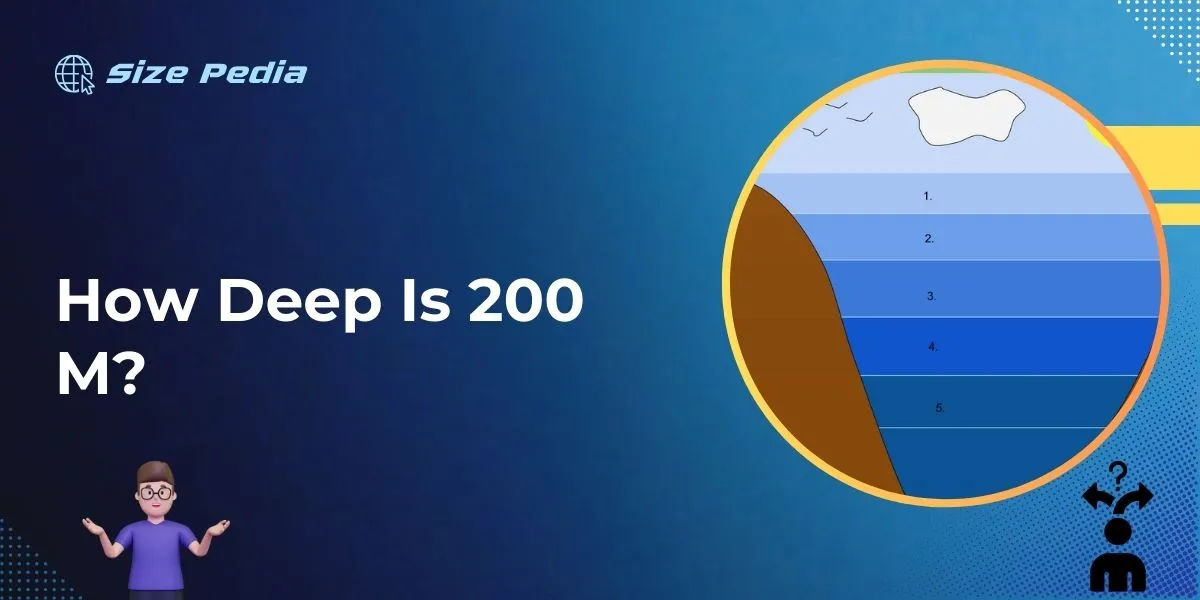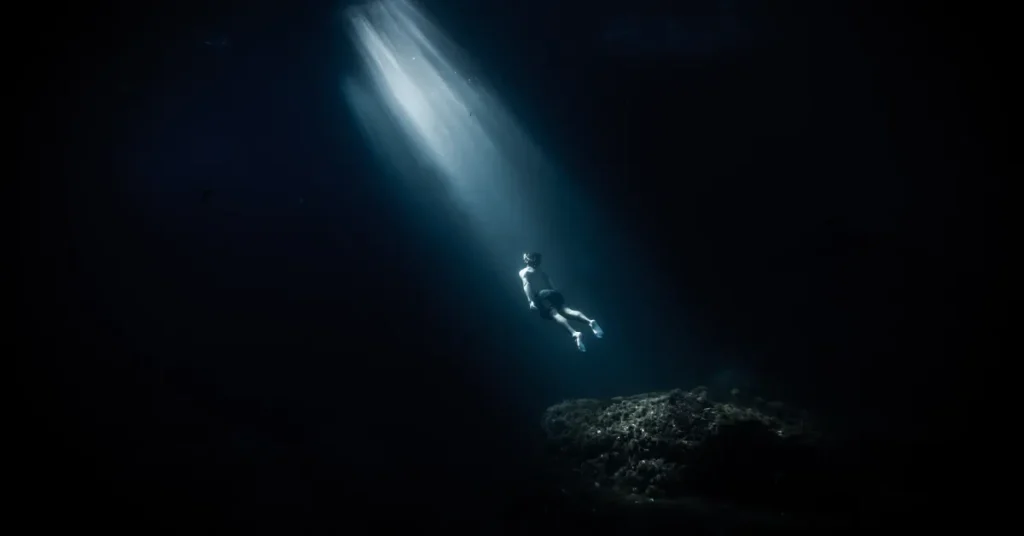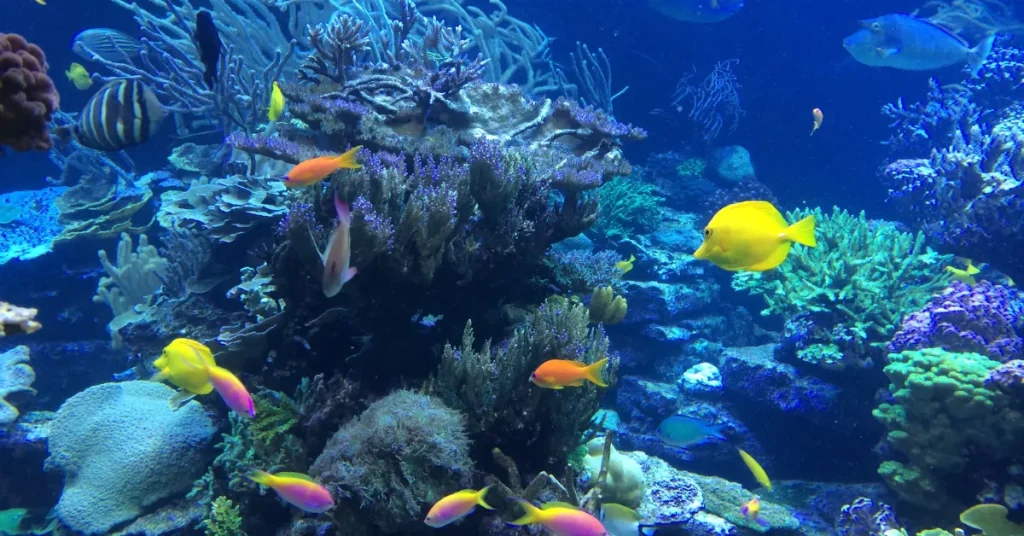200 meters deep corresponds to a depth approximately 656 feet. This measurement is akin to the height of a 60-story building.
Delving into the depths of oceans, lakes, or caves, a 200-meter journey downward takes us into a realm where sunlight begins to wane, and pressure increases significantly.
For divers, this depth marks the threshold beyond recreational limits and enters into technical diving territory.
In engineering and construction, understanding the depth of 200 meters is crucial for projects like bridge foundations and skyscraper basements.
From the perspective of geological or environmental research, this depth can signify a rich zone of biodiversity or a transition in Earth’s strata worth investigating for science.

Plunging Into The Abyss: The Depth Of 200 Meters
Imagine diving into the deep blue sea and sinking lower and lower. You pass 10 meters, where most scuba divers explore. At 50 meters, you’ve reached advanced dive limits. But now, double that depth and add another 100 meters.
That’s 200 meters—a world shrouded in mystery and darkness. This depth, not often reached by humans, offers a new perspective on Earth’s underwater secrets.
Comparing Depths: From Pools To Oceans
How significant is 200 meters? The answer comes alive when contrasting everyday aquatic depths with this profound plunge.
| Aquatic Environment | Average Depth |
| Olympic Swimming Pool | 2 meters |
| Deep Diving Pool | 40 meters |
| Sunken Shipwrecks | 40 – 100 meters |
| 200 Meters Deep | Darker, colder, and vastly unexplored |
It’s clear that few places allow for a direct experience of such a depth without specialized gear or submarines.
Setting The Stage: What Lies At 200 Meters?
At 200 meters, sunlight wanes and the ocean’s twilight zone begins. Creatures adapt to near-total darkness. This zone guards oceanic marvels:
- Bioluminescent Organisms: Mysterious creatures that create light.
- Unique Marine Life: Species unseen near the surface.
- Geological Formations: Canyons and volcanoes teeming with life.
Much remains unknown. The realm at 200 meters continues to attract scientists and explorers eager to uncover its secrets.
The Ocean’s Hidden Layers
The ocean, a vast and mysterious expanse, holds secrets in its depths. Many of these secrets lie beyond direct human observation, tucked away in layers that tell a story about life and survival in dark, pressurized environments.
Embark on a journey to understand the intricate stratifications of our oceanic world, starting with a particular point of interest: the 200-meter mark.
Zones Of The Sea: Demystifying Oceanic Divisions
To comprehend the complexity of the ocean, it’s essential to learn about its different zones. These zones classify the sea by depth, pressure, light, and life forms. Let’s unveil the main layers that compose this underwater tapestry:
- Epipelagic Zone (0-200m): Often called the sunlight zone, this is where most marine life thrives, and photosynthesis occurs.
- Mesopelagic Zone (200-1000m): Known as the twilight zone, it features limited light and a dramatic drop in temperature.
- Bathypelagic Zone (1000-4000m): The midnight zone, where darkness reigns and pressure soars.
- Abyssopelagic Zone (4000-6000m): Named the abyss, it’s incredibly cold and sparse in life.
- Hadalpelagic Zone (6000m+): The trenches, the deepest parts of the ocean, are home to unique creatures.
200 Meters Deep: Entering The Twilight Zone
At 200 meters beneath the ocean’s surface, you enter a realm where sunlight begins to fade. This area marks the start of the Mesopelagic Zone, also known as the twilight zone.
Despite the decreasing light, many species have adapted to life here. The conditions change markedly:
| Attribute | 200m Depth |
| Light | Dim and blue |
| Temperature | Cooler than above |
| Pressure | Increasing significantly |
| Life Forms | Bioluminescent species thrive |
Inhabitants of this zone have unique adaptations, such as bioluminescence, to navigate, hunt, or evade predators. Species like the lanternfish, dragonfish, and squid call this space home, demonstrating incredible resilience and ingenuity.
The twilight zone, while less explored, is essential to understanding the ocean’s biodiversity and its critical role in Earth’s ecology.
Life At 200 Meters Below
Imagine plunging into the depths of the ocean, 200 meters below the waves. This hidden world, shrouded in perpetual twilight, is home to remarkable beings, each uniquely adapted to survive where sunlight dares not linger.
Life at 200 meters below teems with mysteries waiting to unravel.
Creatures Of The Deep: Adapting To Darkness
As we delve deeper into the ocean’s heart, sunlight fades, and darkness reigns. The animals dwelling here have honed incredible features to thrive in the dark.
Bioluminescence paints the sea in strokes of neon blue and green, a vivid display of life unseen anywhere else.
- Anglerfish dangle lures to attract prey.
- Giant squids wield massive eyes to capture every glint of light.
- Deep-sea shrimp produce light to escape predators.
Photosynthesis Cut Off: Surviving Without Sunlight
The magic of photosynthesis, which powers life on Earth, disappears at these depths. Yet life flourishes.
Creatures here rely on chemosynthesis, a process harnessing chemical reactions to fuel life. Hydrothermal vents, spewing minerals, form oases of warmth and nutrients that sustain vast communities.
Key survival strategies include:
- Hunting with precision using specialized senses.
- Forming symbiotic relationships with bacteria.
- Conserving energy by moving slowly or not at all.
Human Interactions With The Deep Ocean
Our blue planet is home to vast and mysterious waters. Surprisingly, 200 meters below the ocean’s surface, sunlight fades and the deep ocean begins. This part of the sea is less explored. Here, humans have made remarkable strides to understand and experience these depths.
Pushing The Limits: Deep Sea Diving And Submersibles
Adventurous souls dive deep into the ocean. They use special gear and techniques. Divers push their limits to explore this hidden world.
The technology behind this goes far beyond simple scuba gear. There are closed-circuit rebreathers and atmospheric diving suits. These allow brave divers to reach and work at depths of up to 200 meters.
Meanwhile, submersibles carry researchers even deeper. These small, agile submarines are engineered marvels. They protect scientists from the crushing pressure while providing glimpses of the unknown.
The Impacts Of Deep Sea Exploration On Marine Life
Every plunge we make affects marine life. The light and noise from vessels can disrupt ocean dwellers. Even the sediment kicked up by submersibles can impact the fragile ecosystems.
Scientists have noted behavior changes in deep sea creatures. This is due to human activities. Such insight leads to improved practices that prioritize marine conservation.
- Revised exploration methods minimize damage
- Marine protected areas get established
- International laws protect vulnerable species
The Mysteries And Challenges Of Deep Sea Research

Exploring the depths of the oceans is like discovering a new world. The deep sea, especially at 200 meters below the surface, presents a realm cloaked in darkness and pressure intense enough to crush most traditional equipment.
Unlocking the secrets of these depths offers insights into untouched ecosystems and previously unknown species.
Yet, the challenges are enormous, as the conditions are harsh and the environment, alien to our common experience.
Technological Marvels: Studying The Inaccessible
The quest to explore deep-sea mysteries relies heavily on cutting-edge technology.
Submersibles and remotely operated vehicles (ROVs) equipped with high-resolution cameras and robust sampling tools have been developed to withstand monumental water pressure.
Autonomous underwater vehicles (AUVs) glide through the darkness with sonar systems, sending back valuable data.
- Deep-sea drones capture real-time video.
- Sophisticated sonars map the ocean floor’s landscape.
- Pressure-resistant materials enable deeper dives.
These innovations offer glimpses into a world teeming with bioluminescent creatures and geothermal vents—environments once thought inhospitable for life.
Conservation Efforts At Deep Sea Levels
Deep sea conservation remains a challenging endeavor. The vulnerability of deep-sea ecosystems calls for responsible exploration and the use of non-intrusive techniques.
Recent advancements have led to initiatives that protect these habitats while allowing research to continue:
- Establishing marine protected areas that encompass deep-sea regions.
- Implementing international regulations for deep-sea mining activities.
- Conducting sustainable fishing practices to prevent overexploitation.
Conservationists use advanced monitoring systems to track changes and ensure the preservation of the deep sea’s delicate balance.
The intersection of technology and conservation is shaping the future of deep-sea exploration. The unfathomable depth of 200 meters is slowly unveiling its secrets, broadening our understanding of the planet’s biodiversity and geological complexity.
Through constant innovation and respectful stewardship, we can ensure the mysteries of the deep are not lost to the darkness.
Embracing The Unknown: What 200 Meters Teaches Us

Dive into the depths as we explore the significance of the number 200. Yes, 200 meters beneath the surface marks a boundary. A boundary between the sunlit waters above and the dark abyss below.
This depth holds many secrets, teaching us valuable lessons about resilience, courage, and the untapped potential of the deep blue.
Let’s embark on a journey to understand how this formidable depth exposes the unknown and invites us into a world of endless possibilities.
Uncharted Realms: Potential Discoveries
The ocean’s unfathomable layers forge a mystery 200 meters down. Here, some of the Earth’s most extraordinary phenomena and species exist. These include:
- Alien-like marine creatures with bioluminescent features.
- Undiscovered ecological systems critical to understanding biodiversity.
- New chemical compounds with the potential for medical breakthroughs.
Researchers often find themselves at the edge of a new discovery at this depth. Innovations in technology continue to unlock secrets and herald new chapters of scientific knowledge.
Each plunge into these uncharted realms becomes a story of potential waiting to unfold.
Life’s Extremes: Lessons From The Deep
Extreme environments like those found at 200 meters challenge life to adapt. The lessons are profound:
| Adaptation | Lesson Learned |
| Thriving in darkness | Resilience, finding light within |
| Resistance to pressure | Strength through adversity |
| Use of limited resources | Innovation, sustainable living |
The resilience of deep-sea organisms shows us how life adapts to thrive where we least expect it. Every discovery about these life forms teaches valuable lessons about survival and innovation.
These creatures illustrate how to overcome challenges by adapting to their surroundings. The deep sea is a living lab for understanding life’s potential amidst extreme conditions.
FAQs About How Deep Is 200 M
How Deep Is 200 Meters In Feet?
200 meters is equivalent to approximately 656. 17 feet. For those who use the imperial system, this provides a clear understanding of the depth when converted from the metric system.
Is 200 Meters A Safe Diving Depth?
No, 200 meters is not considered a safe diving depth for recreational divers. The safe recreational diving limit is generally up to 40 meters. Diving beyond this depth requires specialized training and equipment due to increased risks.
What Marine Life Exists At 200 Meters Deep?
At 200 meters deep, the sunlight starts to diminish, and you can find unique marine life adapted to the darker, colder environment. Species here might include bioluminescent fish, squids, and certain deep-sea corals that thrive in these conditions.
Can Submarines Reach A Depth Of 200 Meters?
Yes, modern military submarines are typically designed to operate at depths exceeding 200 meters. Commercial or research submersibles also frequently dive to this depth for exploration purposes.
Conclusion
Understanding the depth of 200 meters puts vast marine expanses into perspective. Whether for professional divers or ocean enthusiasts, this knowledge is crucial.
While challenging to visualize, it equates to about two football fields stacked end-to-end – a dive deep into the blue, shadowy waters.
Let this spark your curiosity about the incredible depths our planet holds.
Resources:
1. https://oceanexplorer.noaa.gov/facts/deep-ocean.html
